Geography Flash Cards
Here's a really quick way of testing if you've learned the meanings of the key words in this section.
Look at the key word on the card and see if you can remember its definition.
If you get stuck, you can be shown the mnemonic to reveal an image that should help you remember.
To check if you're right, or remind you if you've forgotten, press the card to flip it.
Go through the whole list to see how many definitions you can recall.
Revisit any that you had difficulty remembering until you're confident you can
recall all of them.
A wooden or concrete barrier built out into the sea to stop the longshore drift of sand and shingle and so cause the beach to grow
Groyne
Groyne – A wooden or concrete barrier built out into the sea to stop the longshore drift of sand and shingle and so cause the beach to grow
(Pronounced groin)
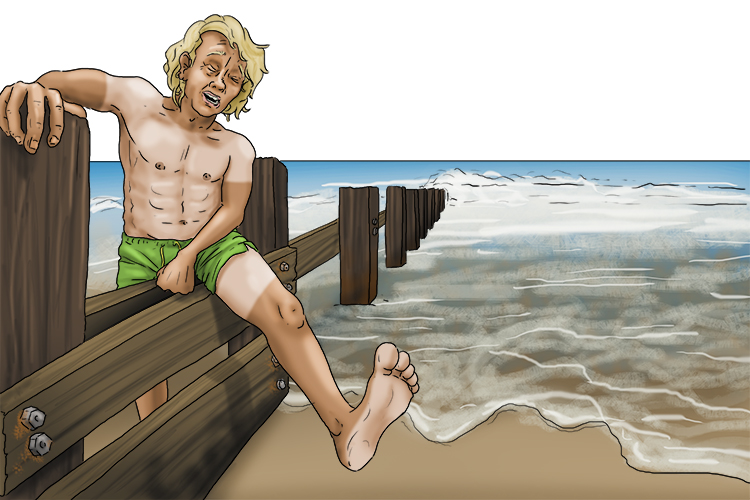
His groin (groyne) was in agony. He had slipped and hurt himself on the wooden barriers at the beach.
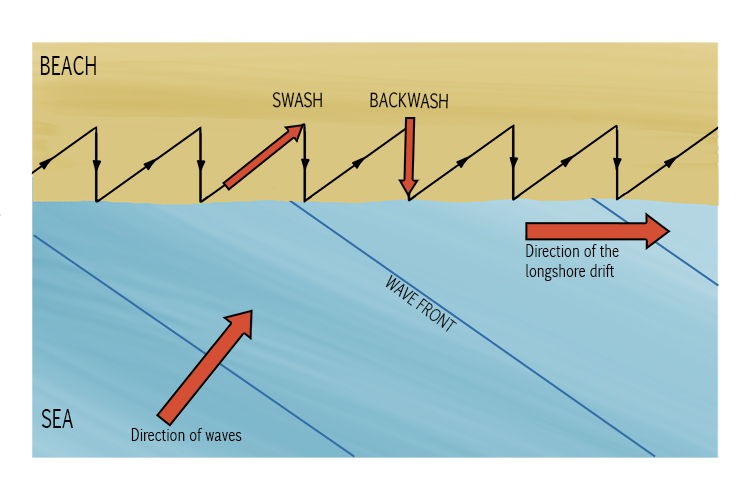
Swash – Think of swash as water coming from the side and washing the sand.
Backwash – Think of backwash as water coming back after washing the sand.
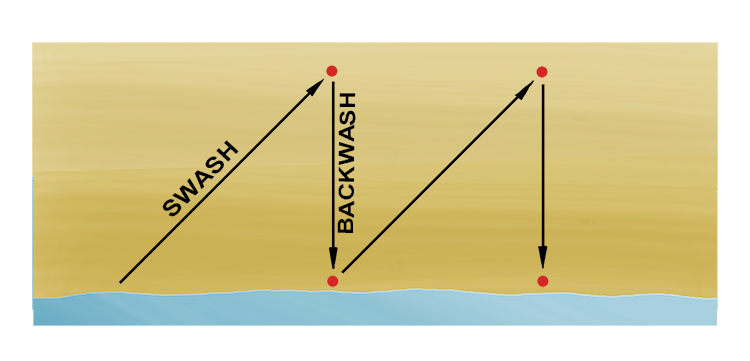
Swash – Material is carried up the beach at an angle.
Backwash – Material is carried straight down the beach as the water retreats.

So, a groyne is a barrier built down the slope of a beach to prevent movement of the sand along the beach by longshore drift.
They do this by interrupting the action of waves that pass over the foreshore at an angle.
Groynes can help to build up the amount of sand on a beach.
Allowing cliff erosion to occur as nature takes its course: erosion in some areas, deposition in others
Managed Retreat
Managed Retreat – Allowing cliff erosion to occur as nature takes its course: erosion in some areas, deposition in others
Benefits include less money spent and the creation of natural environments. It may involve setting back or realigning the shoreline and allowing the sea to flood areas that were previously protected by embankments or seawalls.
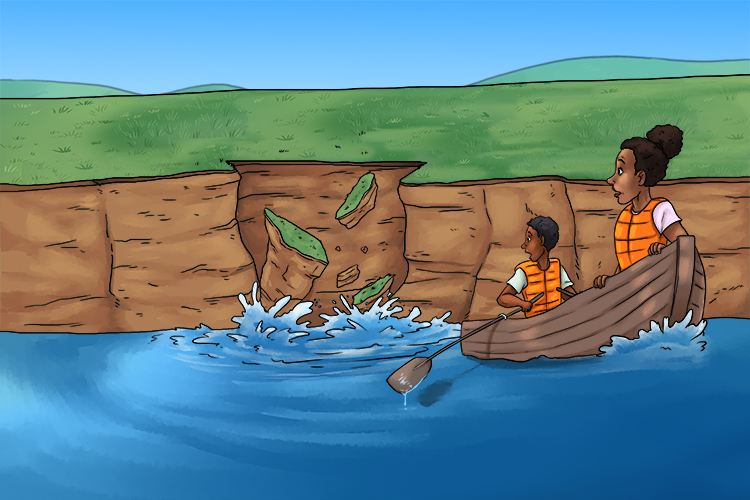
We managed to retreat (managed retreat) before the cliff collapsed.
Apart from allowing cliffs to recede, managed retreat is also about the flooding of lowland areas that previously had flood defence measures in place. It is used in areas where the land is considered to be of low value.
Managed retreat can actually reduce coastal flooding and erosion. While landowners are usually compensated, it is still a less expensive option than protecting the areas.
Managed retreat has other advantages – sometimes including the creation of salt marshes, which are beneficial to the environment, and the gradual development of bigger beaches.
The downhill movement of weathered material under the force of gravity. The speed can vary considerably
Mass Movement
Mass Movement – The downhill movement of weathered material under the force of gravity. The speed can vary considerably
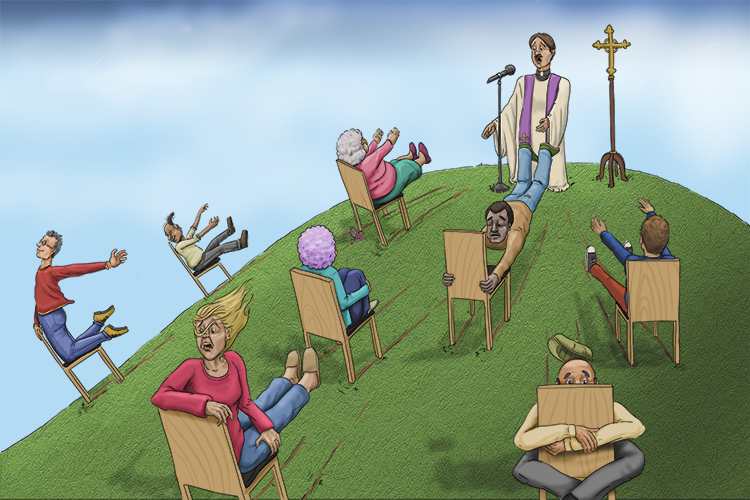
The mass was moving (mass movement) in more ways than one – everyone was falling downhill!
The speed of mass movement can vary considerably depending on the particular type of movement:
Soil creep – where movement is barely noticeable
Slumping – rapid movement
Sliding (or mudflow) – rapid movement.
Rotational slumps are a common type of mass movement on coastlines. Wave action erodes the base of the cliff, removing the cliff's support. Rainfall infiltrates the slope above the cliff through unconsolidated porous material and creates a "slip plane" where it reaches an impermeable material, such as clay.
The increasingly heavy, saturated material above the clay slumps down in a mass movement.
Weathering process that causes physical disintegration or break-up of exposed rock without any change in the chemical composition of the rock, for instance freeze thaw
Mechanical Weathering
Mechanical Weathering – Weathering process that causes physical disintegration or break-up of exposed rock without any change in the chemical composition of the rock, for instance freeze thaw
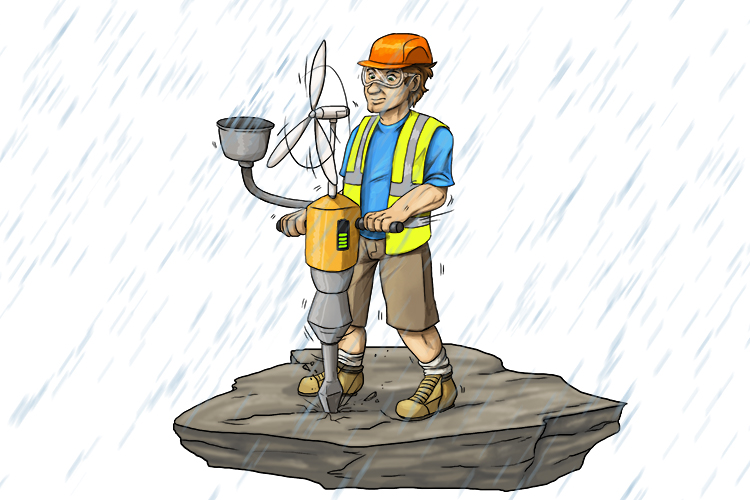
The mechanics all worked on a machine which, when there was bad weather (mechanical weathering), would break up the rock.
There are two main types of mechanical weathering: freeze-thaw and exfoliation.
To learn about freeze-thaw, click the link.
Exfoliation occurs when daytime and night-time temperatures are vastly different on dry rock. During the day, the sun heats up the surface of the rock and at night the outer layers cool down. The continual expansion and contraction gradually disintegrates the top layers.
Large boulders dumped on the beach as part of the coastal defences
Rock Armour
Rock Armour – Large boulders dumped on the beach as part of the coastal defences
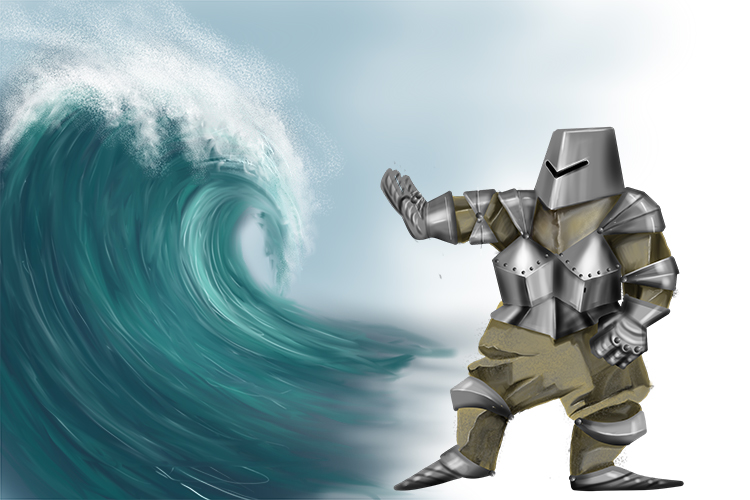
The rock and her armour were what the coast needed to protect itself.
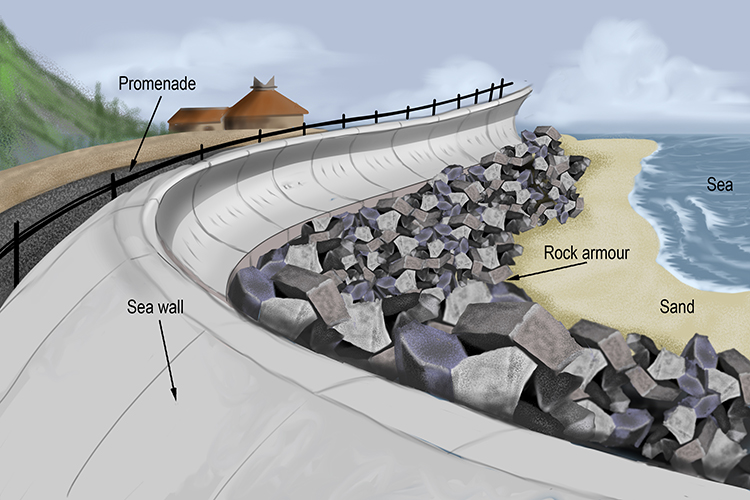
Rock armour is a barrier formed by large boulders that prevents erosion of coastal features such as beaches and cliffs.
Rock armour, also known as riprap, provides protection against serious erosion by absorbing wave energy.
Although regarded as one of the less expensive options, it can still be quite costly to obtain and transport the boulders.
oastal sand hill above high tide mark shaped by wind action, often covered in grasses and shrubs
Sand Dune
Sand Dune – Coastal sand hill above high tide mark shaped by wind action, often covered in grasses and shrubs
We all know what sand dunes are but how are they formed?
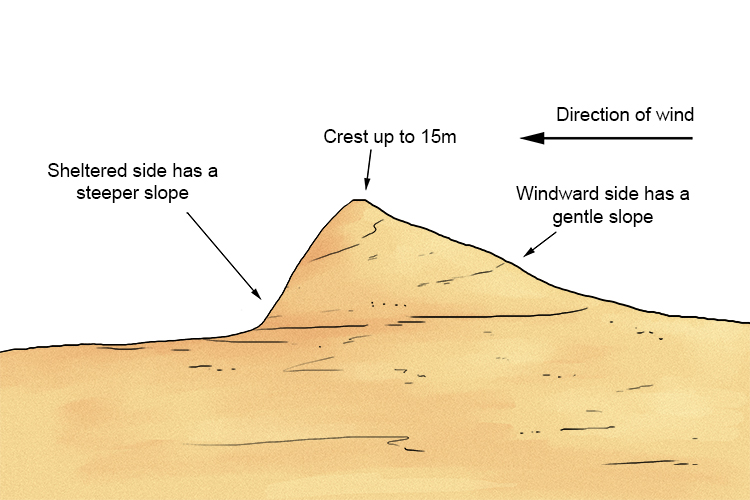
Sand dunes start to form when the wind blows sand into a sheltered area behind an obstacle such as a bush, rock or driftwood. They then continue to grow as more sand accumulates. If vegetation, such as grasses, begins to grow on the dune, its roots will help bind the sand together and stabilise the dune.
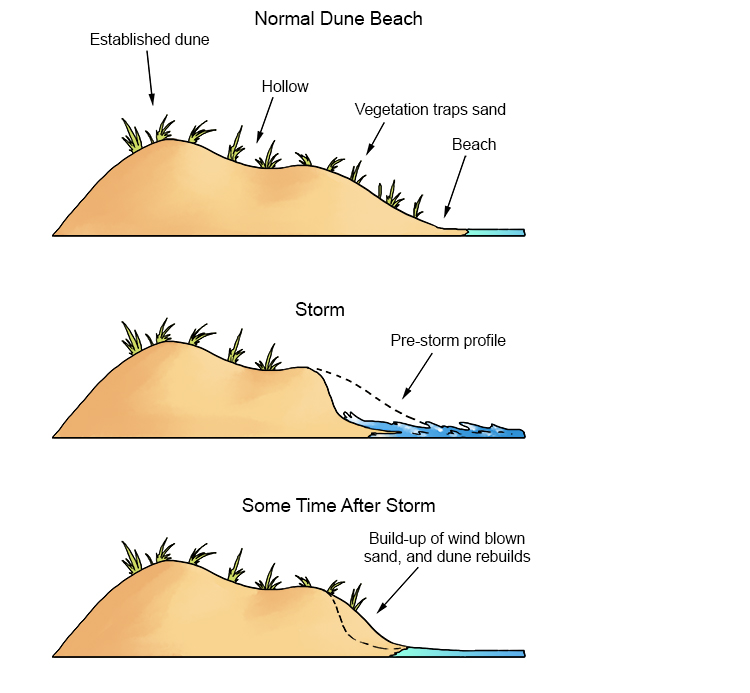
A concrete wall which aims to prevent erosion of the coast by providing a barrier which reflects a wave
Sea wall
Sea wall – A concrete wall which aims to prevent erosion of the coast by providing a barrier which reflects a wave
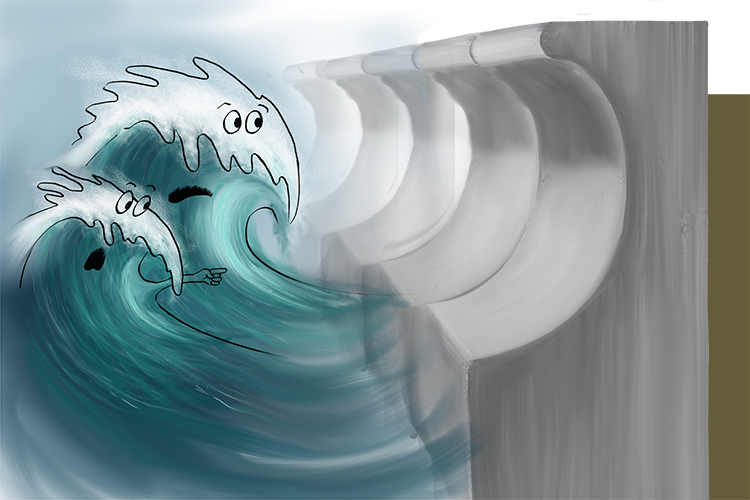
See that wall? (sea wall) It's going to stop us.
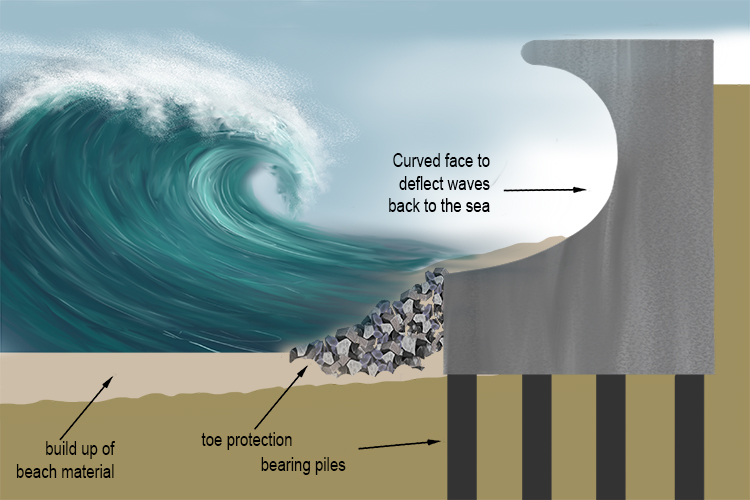
Typical re-curved sea wall which turns the wave energy back on itself.
There are many types of sea walls. All are hard engineered, shore-based structures used to protect the coast from erosion.
The curved concrete sea wall, as in the diagram above, is designed to deflect the energy, reduce undercutting and prevent the wall from being undermined.
Sea walls are usually made of concrete but can also be made from boulders, steel or gabions.
Sea walls are expensive to build and may need costly repairs at some stage as erosion can occur.
Occurs after periods of heavy rain when loose surface material becomes saturated and the extra weight causes the material to become unstable and move rapidly downhill, sometimes in an almost fluid state
Sliding (or mudflow)
Sliding (or mudflow) – Occurs after periods of heavy rain when loose surface material becomes saturated and the extra weight causes the material to become unstable and move rapidly downhill, sometimes in an almost fluid state
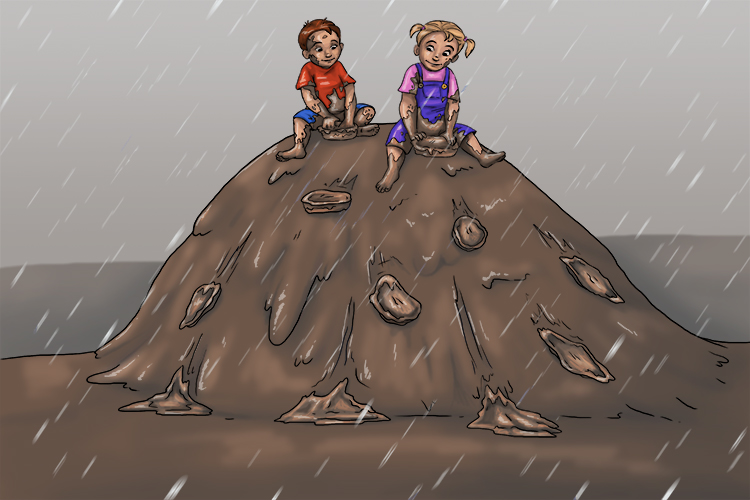
Sliding (sliding) mud pies downhill in the pouring rain made them flow like water.

Sliding involves the movement of material en masse, meaning the material remains together until impacting the bottom of the slope.
A slide happens when a section of soil or rock suddenly gives way and the material moves along a slippery zone, which is often made up of wet sediment.
Rapid mass movement which involves a whole segment of the cliff. Movement is characterised by sliding along a slope, which can be concave or straight, when land is saturated
Slumping
Slumping – Rapid mass movement which involves a whole segment of the cliff. Movement is characterised by sliding along a slope, which can be concave or straight, when land is saturated
Note: Slumping most frequently occurs after removal of a slope base. This can be due to storm wear erosion and road construction.
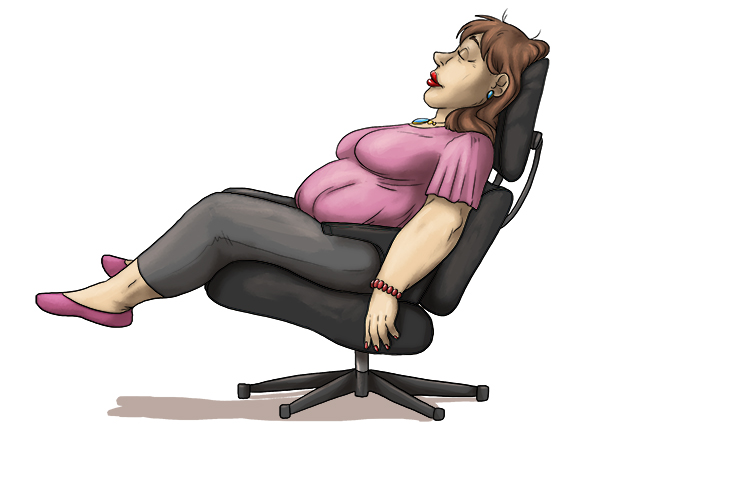
My Mum slumped (slumping) into the chair. She was a mass movement sliding into a curve.
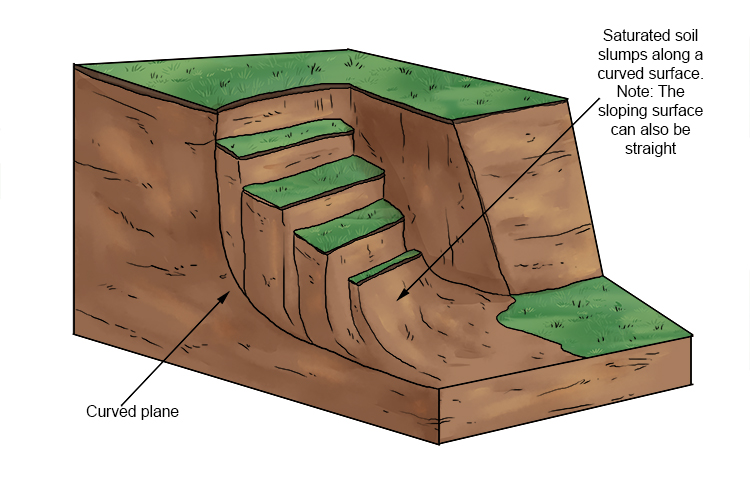
A slump is a type of mass movement that happens when a mass of loosely consolidated materials or a rock layer moves a short distance down a slope.
The cut which forms as the landmass breaks away from the slope is called the scarp and is often cliff-like and concave (curved inwards).
Use of the natural environment of a coastline for schemes that work with the sea's natural processes
Coastal Soft Engineering
Soft Engineering – Use of the natural environment of a coastline for schemes that work with the sea's natural processes
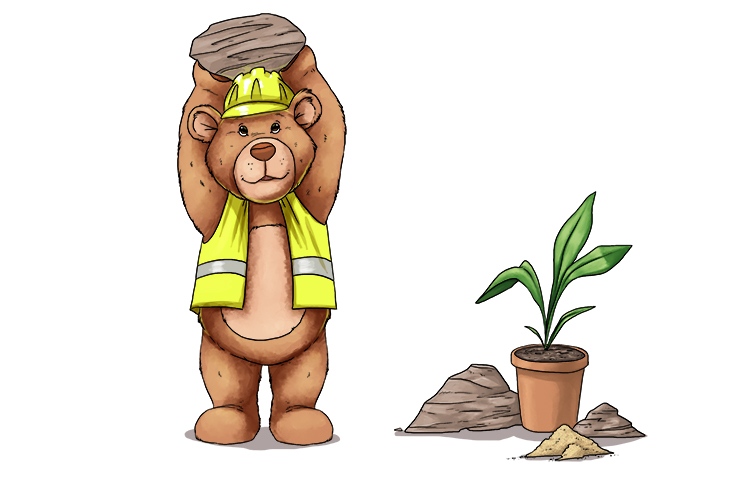
The soft engineer (soft engineering) wasn't really that soft - he used stones, sand and other materials as well as plants.
Below are examples of soft engineering on the coast:
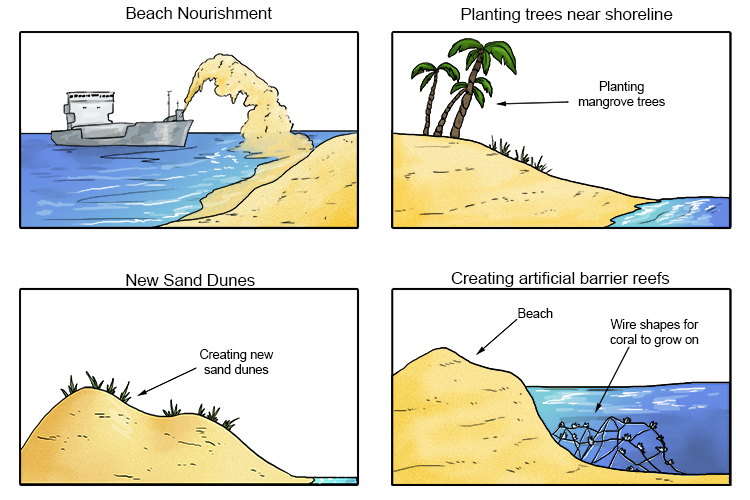
Soft engineering is about working with nature to defend coastlines from erosion. It is typically inexpensive, long-term and sustainable.
Hard engineering, on the other hand, means creating artificial structures, which are often considered to be short-term, expensive and unsustainable.
Slowest of mass movements, occurs on gentle, well vegetated slopes. Moves because of the way the soil particles repeatedly expand and contract in wet and dry periods
Soil Creep
Soil Creep – Slowest of mass movements, occurs on gentle, well vegetated slopes. Moves because of the way the soil particles repeatedly expand and contract in wet and dry periods

The soil started to creep (soil creep) downhill - but so slowly that no one noticed.
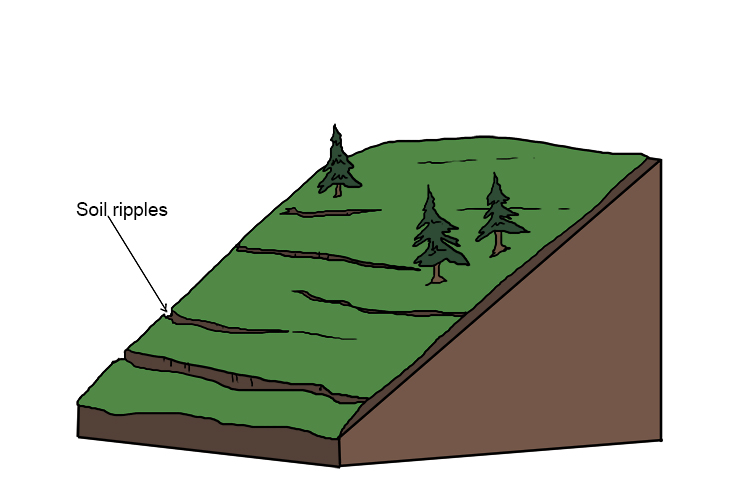
The soil may move less than a centimetre a year, but over time the results can be seen in small, step-like terraces on hillsides.
To understand soil creep, think of a sandcastle. It will only stand up when it is made with damp sand – the water offers cohesion to the sand, binding the sand particles together. However, pouring water over the sandcastle destroys it, because too much water fills the gaps between the grains, creating a slip plane between the particles and causing them to slip and slide away.
It is the same with soil creep on hillsides. Dampness helps the hillside to stay put, but after a lot of rain the gaps between the grains become saturated, causing the ground to slide along the slip plane it creates.
Creep can also be caused by the expansion of materials, such as clay, when they are exposed to water. Clay expands when wet, then contracts after drying. The expansion pushes downhill and the contraction results in consolidation at the new position.
A depositional landform formed when a finger of sediment extends from the shore out to sea, often at a river mouth. It usually has a curved end because of opposing winds and currents
Spit
Spit – A depositional landform formed when a finger of sediment extends from the shore out to sea, often at a river mouth. It usually has a curved end because of opposing winds and currents
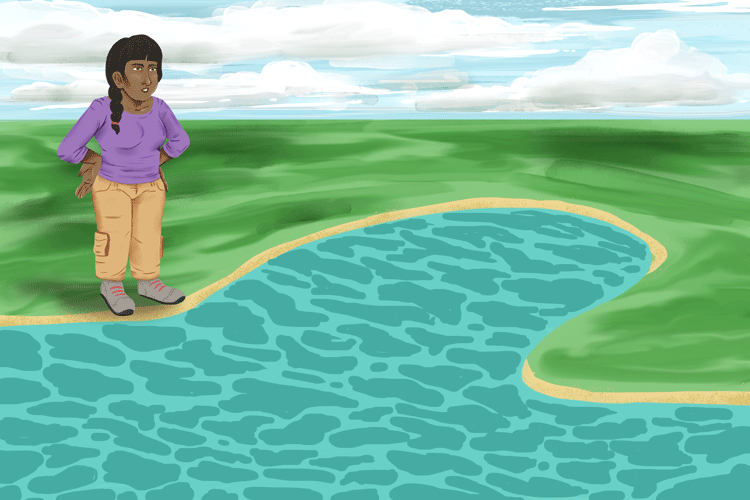
She would spit into the sea and watch it form a landform. The wind caught the end of the spit so it curved in.
How they are really formed is as shown below:
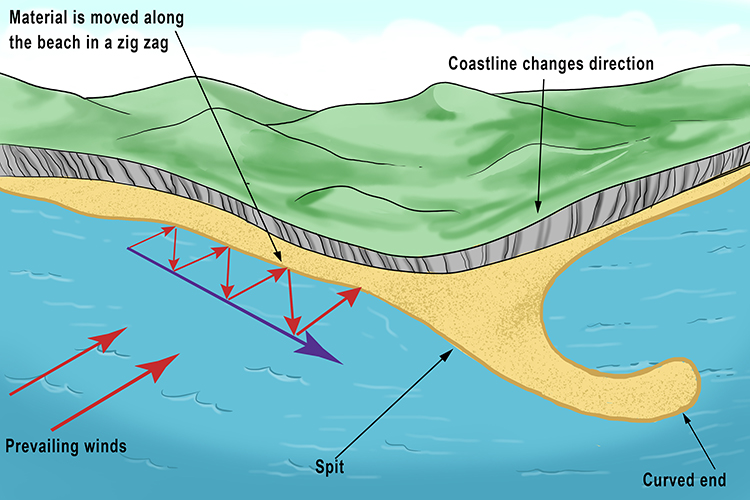
Where there is a prevailing wind blowing at an angle to the coastline, longshore drift can occur. This is the continual movement of sand and pebbles along a beach in a zig-zag pattern, due to the tide coming in at an angle and then going out straight, or perpendicular to the shore. (See longshore drift for a more detailed explanation).
When this longshore drift action reaches a curve or "corner" in the coastline, the sand moved along by the longshore drift is deposited. The deposited sand gradually builds up until it becomes a spit extending out into the sea.
Spits are often formed at the mouths of estuaries, where rivers flow out into the sea.
An isolated pillar of rock left when the top of an arch has collapsed. Over time further erosion reduces the stack to a smaller, lower stump
Stack
Stack – An isolated pillar of rock left when the top of an arch has collapsed. Over time further erosion reduces the stack to a smaller, lower stump

A stack of money looks like a coastal stack.
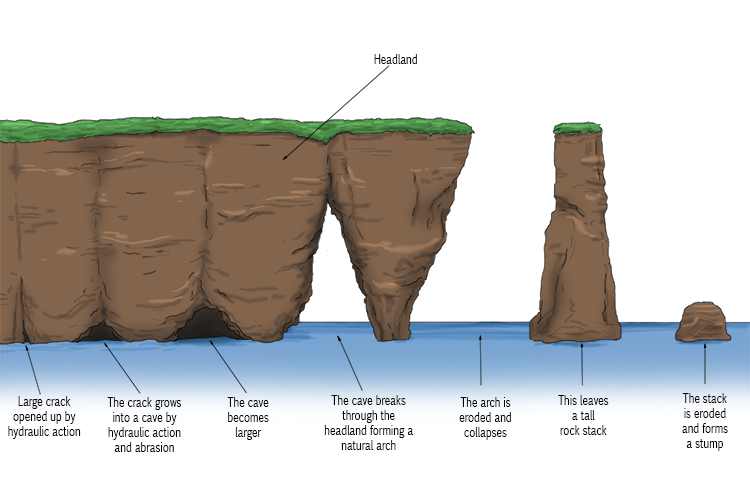
A stack looks like a tall stone tower separated from the main coastline. It can take thousands or even millions of years for a stack to form, but the process is always as illustrated above.
See hydraulic power for details of how hydraulic action has the power to break through rocks.
Ripples in the sea caused by the transfer of energy from the wind blowing over the sea
Waves
Waves – Ripples in the sea caused by the transfer of energy from the wind blowing over the sea
The largest waves are formed when winds are very strong, blow for lengthy periods and cross large expanses of water.
Waves are caused by the transfer of energy from the wind to the sea (not to be confused with the tides which are caused by the gravitational pull of the moon and the sun, although this also does cause waves). As the wind blows over the surface of the sea it creates friction, forming waves.
The characteristics of waves are determined by the strength of the wind, its duration and fetch (distance it travels).
The stronger the wind, the greater the friction on the surface of the sea, and therefore the bigger the wave.
The size of a wave depends on its fetch. The fetch is the distance a wave travels, the greater the fetch the larger the wave.
In deep water, water molecules within a wave move in a circular movement. It is only in shallow water that the shore creates friction and turns the wave to break.
NOTE: Apart from wind (the main cause), waves are also caused by the gravitational pull of the sun and moon. This gravitational pull causes tides (literally the raising of large areas of the sea by gravitational pull), which result in tidal waves. Not so commonly, waves are also caused by underwater disturbances such as earthquakes, landslides and volcanic eruptions. These very big waves, called tsunamis, travel over the shore and can reach far inland.
A rocky shelf/flat bed at or around sea level, representing the base of old, retreated cliffs
Wave-Cut Platform
Wave-Cut Platform – A rocky shelf/flat bed at or around sea level, representing the base of old, retreated cliffs

She waved as she stood on the newly cut out platform (wave-cut platform). Good job there were no big waves otherwise she might have been washed away.
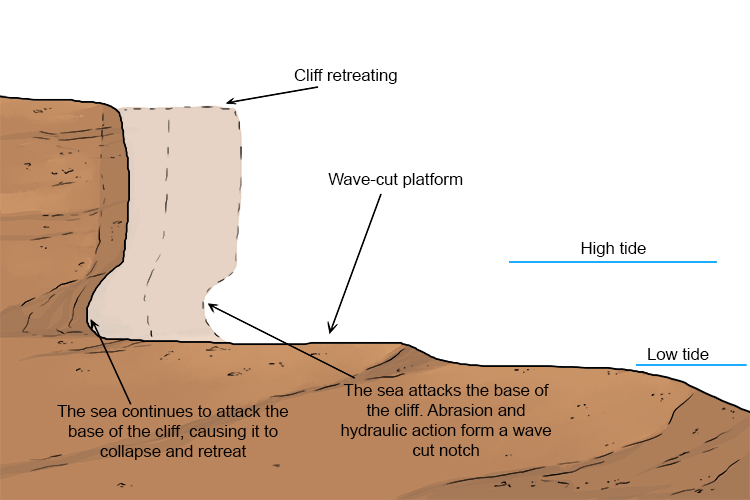

A wave-cut platform forms when waves impact against a cliff face. Where the waves strike, a recess forms as rock is gradually eroded. The cliff is undermined and the rock above collapses repeatedly as the cliff retreats inland over thousands, even millions, of years.
The wave action takes place between high and low tides, which results in a clearly defined "cut" into the rock. At low tide level, a flat area of rock grows ever bigger. This is the wave-cut platform which can occupy surprisingly large areas.
Evidence of different sea and lake levels in the past is provided by ancient wave-cut platforms. Raised and abandoned platforms, sometimes found behind today's beaches, show that water levels were once higher.
The movement of material by suspension, solution, traction and saltation
River Transportation
Transportation – The movement of material by suspension, solution, traction and saltation
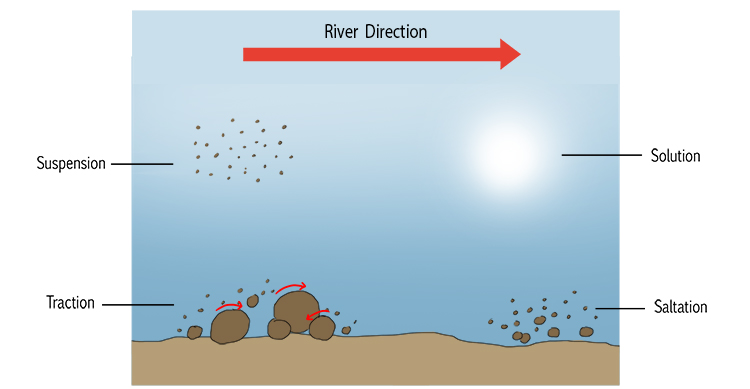
Types of transportation:
Suspension: Fine, light material is carried along by the river.
Solution: Minerals are dissolved in the water.
Traction: Large boulders and rocks are rolled along the river bed.
Saltation: Small pebbles and stones are bounced along the river bed.
To remember that transportation moves in four ways – suspension, solution, traction and saltation – recall the following:
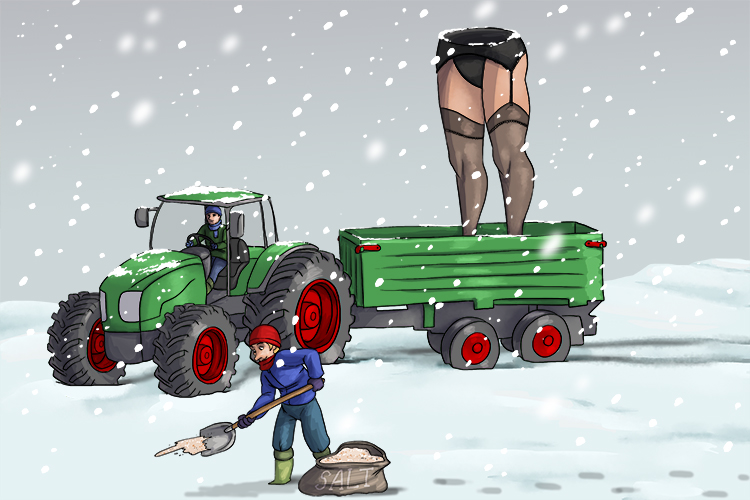
Transport (transportation) was the solution (solution) to moving the large suspenders (suspension) so a tractor (traction) was used, but they had to salt (saltation) the roads first.
Transportation is all about the movement downstream of materials that have broken loose as a result of erosion. This eroded material is generally referred to as sediment.
The sediment moves faster nearer the river's source, where it flows quickly down steeper inclines. Where a river approaches the sea over flatter land, the flow is reduced and the sediment is deposited.
This can result in the "silting up" of river estuaries – granular material is deposited over time, causing obstructions that result in new channels and deltas.
The wearing away and removal of material by turning it into a solution or by attrition, abrasion or hydraulic action
River Erosion
Erosion – The wearing away and removal of material by turning it into a solution or by attrition, abrasion or hydraulic action

Types of erosion:
Solution: The sides of the river dissolve into the water.
Attrition: Wearing down the river bed by bouncing into the sides of the river and breaking off particles.
Abrasion: Wearing down the river bed by grinding, rubbing, scratching and scuffing like sandpaper.
Hydraulic Action: The force of water against riverbanks compresses air into cracks, which expands and fractures the rock over time.
To remember that erosion is attrition, abrasion, hydraulic action and turning material into a solution, learn the following story:

Eros, he rose up upon (erosion) a hydrant and started acting on it (hydraulic action). First, he tried being a donkey and made a braying (abrasion) sound that gave everyone a headache, so the solution (solution) was two headache pills. They did stay, however, to see Eros do a trick on (attrition) the hydrant.
The erosive power of a river over time is perhaps best illustrated by land formations such as America's Grand Canyon. Water running off the Rocky Mountains formed the mighty Colorado River, which cut into the rock, sometimes changing direction as obstacles were encountered and then worn away. This action carved out the canyon over millions of years.
Fine, solid material held in the water while the water is moving
River Suspension
Suspension – Fine, solid material held in the water while the water is moving
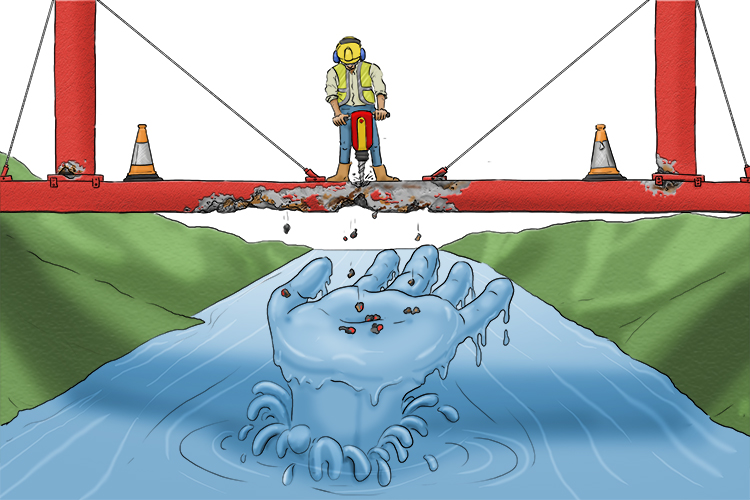
The rust on the suspension (suspension) bridge was all removed by the maintenance team and the small particles were held in the water.
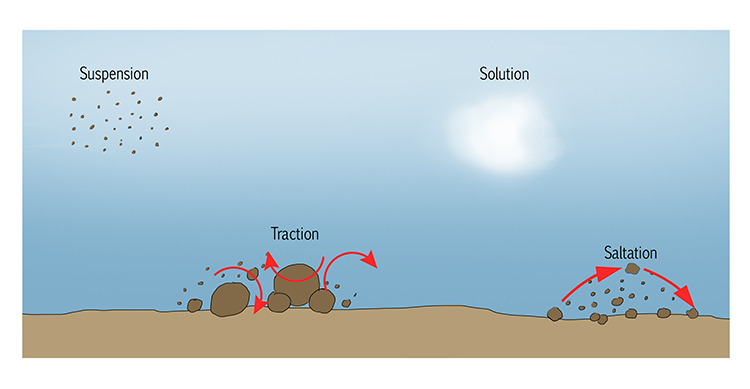
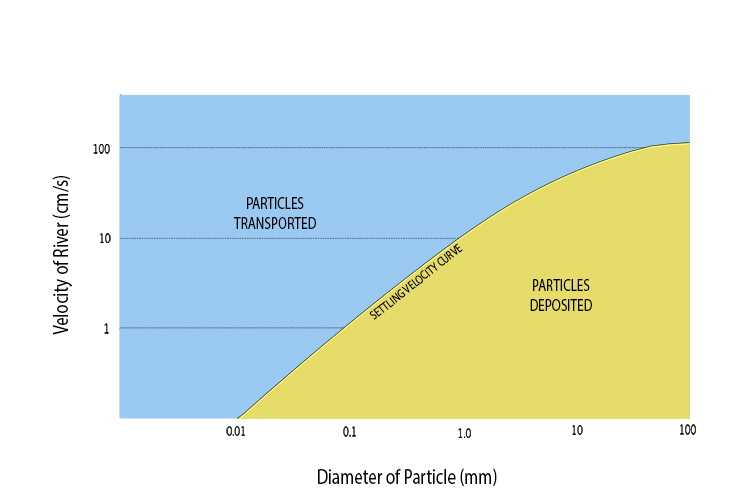
The graph above shows how the speed at which water is flowing (velocity) and the size of the particles suspended in the water affect the point at which the particles are deposited (settle at the bottom of the river).
As an example, a particle measuring 0.1cm settles at a water speed of about 1cm per second. But a particle measuring 1cm (ten times bigger) settles when the water is moving at around 10cm per second.
This means that particles of different sizes are deposited at different distances along the course of a river, the smallest particles falling to the bottom at the river's slowest point, usually where it meets the sea or a large lake.
Particles bouncing along the river bed (bouncing is the important word)
River Saltation
Saltation – Particles bouncing along the river bed (bouncing is the important word)
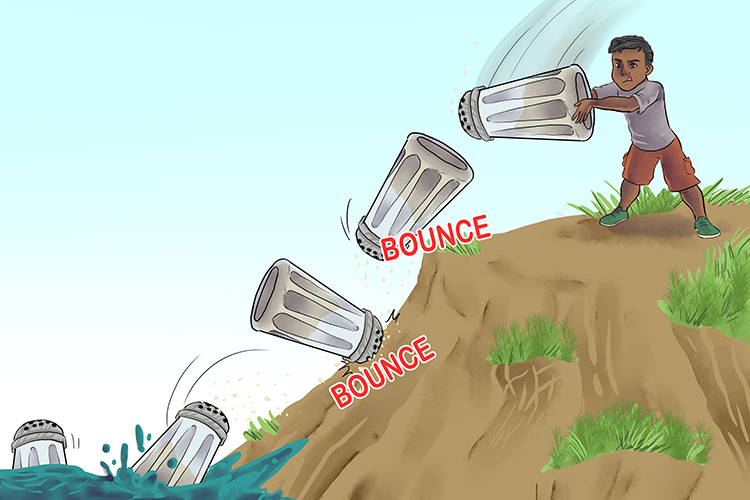
Too much salt was killing the nation (saltation), so the government ordered all salt pots to be bounced into the river.
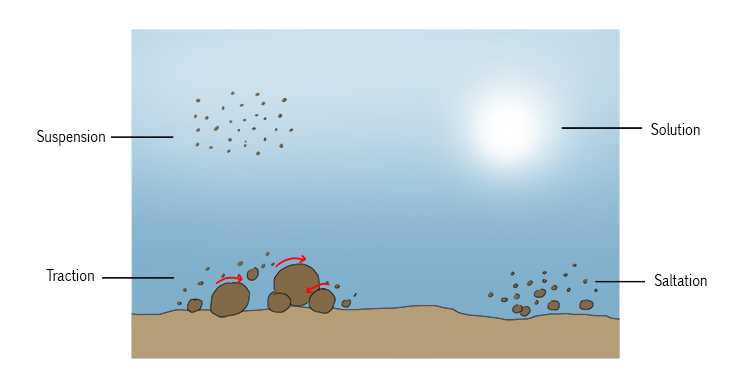
In saltation, small rocks or pebbles which are too big to be carried wholly within the water are bounced along the bottom of the river bed by the force of the flow or current.
Saltation happens usually near the river's source, where the water is flowing faster and so has more force. Once rivers reach lower ground, they generally have insufficient force to move larger particles.
Soluble particles are dissolved in to the river. A liquid mixture in which the minor component is uniformly distributed within the major component
River Solution
Solution – Soluble particles are dissolved in to the river. A liquid mixture in which the minor component is uniformly distributed within the major component
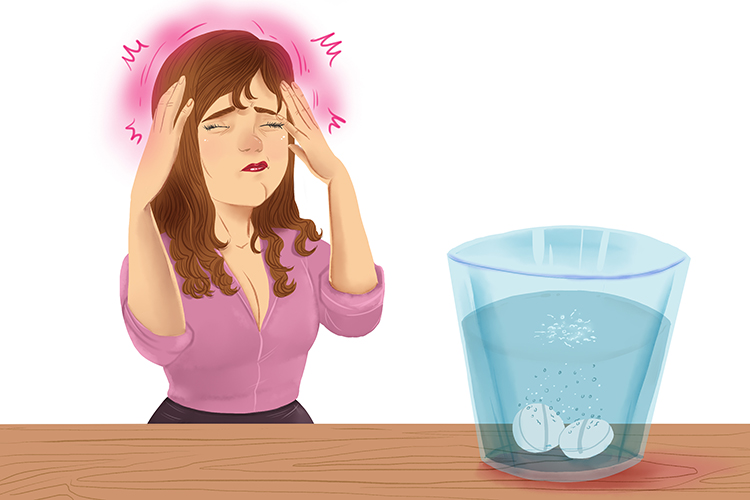
The solution to her headache was to dissolve two headache pills in a glass of water and drink it quickly.

The particles that are dissolved into rivers to form a solution usually come from limestone or chalk.
A solution is not the same as a suspension: A solution is a mixture of ions or molecules (very, very small). Solutions are transparent, meaning that you can see through them. A suspension has bigger particle sizes and often looks cloudy or murky.
NOTE: Water that contains a solution might still look murky because a suspension is also present.










































